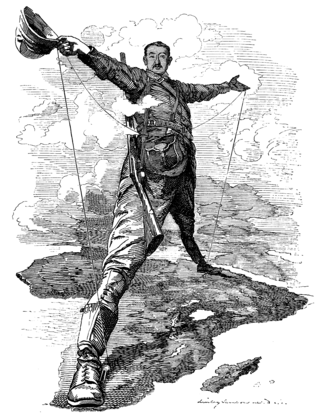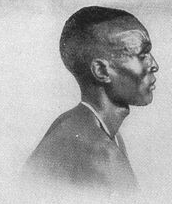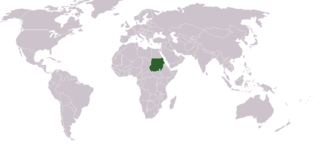
Sudan, officially the Republic of the Sudan, is a country in Northeast Africa. It borders the Central African Republic to the southwest, Chad to the west, Egypt to the north, Eritrea to the northeast, Ethiopia to the southeast, Libya to the northwest, South Sudan to the south, and the Red Sea. It has a population of 45.7 million people as of 2022 and occupies 1,886,068 square kilometres, making it Africa's third-largest country by area and the third-largest by area in the Arab League. It was the largest country by area in Africa and the Arab League until the secession of South Sudan in 2011; since then both titles have been held by Algeria. Its capital city is Khartoum, and its most populous city is Omdurman.
The Nilotic peoples are people indigenous to the Nile Valley who speak Nilotic languages. They inhabit South Sudan, Sudan, Egypt, Ethiopia, Uganda, Kenya, the Democratic Republic of the Congo, Rwanda, Burundi and Tanzania. Among these are the Burun-speaking peoples, Karo peoples, Luo peoples, Ateker peoples, Kalenjin peoples, Datooga, Dinka, Nuer, Atwot, Lotuko, and the Maa-speaking peoples.

The Fashoda Incident, also known as the Fashoda Crisis, was an international incident and the climax of imperialist territorial disputes between Britain and France in East Africa, occurring in 1898. A French expedition to Fashoda on the White Nile river sought to gain control of the Upper Nile river basin and thereby exclude Britain from the Sudan. The French party and a British-Egyptian force met on friendly terms, but back in Europe, it became a war scare. The British held firm as both empires stood on the verge of war with heated rhetoric on both sides. Under heavy pressure, the French withdrew, ensuring Anglo-Egyptian control over the area.

The Scramble for Africa, also known as the Partition of Africa, or the Conquest of Africa, was the invasion, annexation, division, and colonization of most of Africa by seven Western European powers during an era known as "New Imperialism". The 10 percent of Africa that was under formal European control in 1870 increased to almost 90 percent by 1914, with only Liberia and Ethiopia remaining independent.

French Sudan was a French colonial territory in the Federation of French West Africa from around 1880 until 1959, when it joined the Mali Federation, and then in 1960, when it became the independent state of Mali. The colony was formally called French Sudan from 1890 until 1899 and then again from 1921 until 1958, and had a variety of different names over the course of its existence. The colony was initially established largely as a military project led by French troops, but in the mid-1890s it came under civilian administration.

The Beja people are an ethnic group native to the Eastern Desert, inhabiting a coastal area from southeastern Egypt through eastern Sudan and into northwestern Eritrea. They are descended from peoples who have inhabited the area since 4000 BC or earlier, although they were Arabized by Arabs who settled in the region. They are nomadic, and live primarily in the Eastern Desert. They number around 1,900,000 to 2,200,000 people. Most of the Beja speak Arabic, while some speak the Cushitic language of Beja and the Semitic language of Tigre. In Eritrea and southeastern Sudan, many members of the Beni-Amer grouping speak Tigre. Originally, the Beja did not speak Arabic, however the migration of the numerous Arab tribes of Juhaynah, Mudar, Rabi'a, and many more to the Beja areas contributed to the Arabization and Islamization of them, however the Arabs did not fully settle in the Beja areas as they looked for better climate in other areas. The Beja have partially mixed with Arabs through intermarriages over the centuries, and by the 15th century were absorbed into Islam. The process of Arabization led to the Beja adopting the Arabic language, Arab clothing, and Arab kinship organization.

The Dinka tribe are a Nilotic ethnic group native to South Sudan with a sizable diaspora population abroad. The Dinka mostly live along the Nile, from Bor to Renk, in the region of Bahr el Ghazal, Upper Nile, and the Abyei Area of the Ngok Dinka in South Sudan.

Slavery in Sudan began in ancient times, and had a resurgence during the Second Sudanese Civil War (1983–2005). During the Trans-Saharan slave trade, many Nilotic peoples from the lower Nile Valley were purchased as slaves and brought to work elsewhere in North Africa and the Orient by Nubians, Egyptians, Berbers and Arabs.

The First Sudanese Civil War was a conflict from 1955 to 1972 between the northern part of Sudan and the southern Sudan region that demanded representation and more regional autonomy. Around a million people died over the nearly 17 years and the war was divided into four major stages: initial guerrilla warfare, the creation of the Anyanya insurgency, political strife within the government and establishment of the South Sudan Liberation Movement.
As of the early 2000s, Sudan had one of the most restrictive media environments in Africa. Sudan’s print media since independence generally have served one of the political parties or the government in power, although there occasionally were outspoken independent newspapers.
Sudanese literature consists of both oral as well as written works of fiction and nonfiction that were created during the cultural history of today's Republic of the Sudan. This includes the territory of what was once Anglo-Egyptian Sudan, the independent country's history since 1956 as well as its changing geographical scope in the 21st century.
The Revolutionary Command Council for National Salvation (RCCNS-Sudan) was the governing body of Sudan following the June 1989 coup. It grew out of the collaboration between the Sudanese military and the National Islamic Front. It was the authority by which the military government of Sudan under Lt. Gen. Omar al-Bashir exercised power.
This is a timeline of Sudanese history, comprising important legal and territorial changes and political events in Sudan and its predecessor states. To read about the background to these events, see History of Sudan. See that the [[list of governors of pre-independence list of heads of state of Sudan.

The following outline is provided as an overview of and topical guide to Sudan:

South Sudan, officially the Republic of South Sudan, is a landlocked country in East Africa. It is bordered by Ethiopia, Sudan, the Central African Republic, the Democratic Republic of the Congo, Uganda, and Kenya. Its population was estimated at 10,913,164 in 2022. Juba is the capital and largest city.
The mass media in South Sudan is underdeveloped compared to many other countries, including fellow East African states like Kenya, Tanzania, and Uganda. Poor transportation infrastructure and entrenched poverty in the country inhibit both the circulation of newspapers, particularly in states located far from the capital of Juba, and the ability of media outlets to maintain regular coverage of the entire country.
The following is a timeline of the history of the city of Khartoum, Sudan.
The Vigilant was an English-language newspaper published from Khartoum, Sudan. The first issue was published on March 23, 1965. It was an organ of the Southern Front. It functioned as a relatively well-written informative newsletter, and became the mouthpiece of the Southern movement in general and the Southern Front in particular. Effectively it was the sole press outlet for Southern opinions.

Photography in Sudan refers to both historical as well as to contemporary photographs taken in the cultural history of today's Republic of the Sudan. This includes the former territory of present-day South Sudan, as well as what was once Anglo-Egyptian Sudan, and some of the oldest photographs from the 1860s, taken during the Turkish-Egyptian rule (Turkiyya). As in other countries, the growing importance of photography for mass media like newspapers, as well as for amateur photographers has led to a wider photographic documentation and use of photographs in Sudan during the 20th century and beyond. In the 21st century, photography in Sudan has undergone important changes, mainly due to digital photography and distribution through social media and the Internet.










